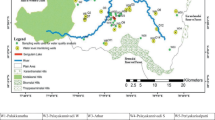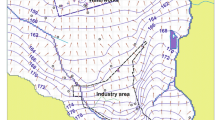Abstract
This study was undertaken to support a remediation technique that will be applied to contaminated groundwater in the vicinity of Ghonan landfill, eastern Saudi Arabia. Preliminary field investigations involved hydrogeological characterization of the entire area. The improved understanding of the underlying geology and groundwater movement gained from the preliminary studies helped in determining a test site within the proximity of the landfill. One remediation well and five monitoring wells were constructed at the test site. Optimum pumping rate for the remediation well was determined to range from 2.642 through 7.926 gallons per minute (gpm) (0.01 m3/min through 0.03 m3/min) based on site-specific hydrogeological investigations and mathematical simulation. A concentration of 0.05 mg/L of methyl tertiary-butyl ether (MTBE) contaminated the aquifer in the test site. The simulated concentration of MTBE at the point of exposure after a period of 2 years was found to be higher than the maximum contaminant level of 0.005 mg/L set by the United States Environmental Protection Agency (U.S. EPA). The results of risk assessment conducted revealed that domestic use of groundwater in the study area through any of the exposure pathways (ingestion, dermal contact, and inhalation in the shower) may lead to development of health risks to human receptors. The landfill, which is being operated as a hazardous landfill and a dump site, may become a source of groundwater pollution in its vicinity in the near future. As a potential health risk, it should be controlled properly by remediating the aquifer and implementing environmental measures to the landfill users.









Similar content being viewed by others
References
Abderrahman WA, Rasheeduddin M (1994) Groundwater budgeting for a multi-aquifer system using numerical techniques, Arab Gulf. J Sci Res 12:29–40
Abderrahman WA, Rasheeduddin M, Ibrahim MH, Esuflebbe JM, Eqnaibi B (1995) Impacts of management practices on groundwater condition in Eastern Province, Saudi Arabia. Hydrogeol J 3:32–41
Al-Saafin AK, Bader TA, Hötzl H, Shehata W, Wohnlich S, Zötl JG (1990) Groundwater recharge in an arid karst area in Saudi Arabia, Selected papers on hydrogeology, vol 1. Heise, Hannover, pp 29–41, 6 Abb., 2 Tab
Al-Shuhail AA, Al-Shaibani AM (2012) Characterization of SabkhaJaybUwayyid, eastern Saudi Arabia using seismic refraction profiling. Arab J Geosci. doi:10.1007/s12517-011-0366-8
Apgar M, Satherthwaite WB (1975) Groundwater contamination associated with the Llangollen landfill, Newcastle County, Delaware. Proceedings of Research Symposium, Gas and leachates from landfills: formation, collection and treatment, New Brunswick, New Jersy, 15–18 March 1975
ASTM D6431 – 99 (2010) Standard guide for using the direct current resistivity method for subsurface investigation. http://www.astm.org/Standards/D6431.htm. Accessed 12 October 2012
Backiewicz W, Milne DM, Noori M (1982) Hydrogeology of Umm Er Radhuma aquifer, Saudi Arabia, with reference to fosil gradients. J Eng Geol 15:105–126
Benischke R, Fuchs G, Weissensteiner V (1991) Karst phenomena of the Arabian Shelf Platform and their Influence on Underground Aquifers. Fourth Report. Speleological Investigations in the Shawyah-Ma'aqla Region, Eastern Province, Saudi Arabia, Vol. I, pp 70, 1 fig.; Vol. II, 14 maps, Graz
Bhalla G, Swamee PK, Kumar A, Bansal A (2012) Assessment of groundwater quality near municipal solid waste landfill by an Aggregate Index Method. Int J Environ Sci 2:1492–1503
BRGM (Bureau de Recherches Géologiques et Minières) (1977) Al Hassa development project. Groundwater development studies and management programme. Final report, vol. 3, App II-7, Results of isotopic analysis, BRGM, Paris
Burdon DJ (1982) Hydrogeological conditions in the Middle East. Q J Eng Geol 15:71–82
Cushman DJ, Driver KS, Ball SD (2001) Risk assessment for environmental contamination: an overview of the fundamentals and application of risk assessment at contaminated sites. Can J Civ Eng 28:155–162
Edgell HS (1997) Aquifers of Saudi Arabia and their geological framework. Arab J Sci Eng 22:3–31
GDC (Groundwater Development Consultant) (1979) Final draft of Umm-Er-Radhuma, Ministry of Agriculture and Water, Riyadh
Golwer A, Matthess G, Schneider W (1975) Effects of waste deposits on groundwater quality. In Groundwater Pollution, Proceedings of the Moscow Symposium, 1971, 159–166: 1AHS Publ. no.103
GSI (Golden Software Inc.) (2002) Surfer8 user’s guide. Contouring and 3D surface mapping for scientists and engineers. http://www.wi.zut.edu.pl/gis/Surfer_8_Guide.pdf. Accessed 16 August 2012
GSSI (Geophysical Survey Systems Inc.): RADAN® 7: Optimized for Windows® 7. http://www.geophysical.com/software.htm. Accessed 11 September 2012
Hvorslev (1951) Time lag and soil permeability in groundwater observations, Waterways Experiment Station Corps of Engineers. U. S. Army, Vicksburg
HydroSOLV Inc. (2007) AQTESOLV manuals, all-in-one software package for the analysis of pumping tests, slug tests and constant-head tests. http://www.aqtesolv.com/manual.asp. Accessed 26 August 2012
Italconsult (1969) Water and agriculture development studies for Area IV, Final Report, Ministry of Agriculture and Water, Riyadh
Iwalewa TM, Makkawi MH, Elamin AS, Al-Shaibani AM (2013a) Groundwater management case study, eastern Saudi Arabia: Part I—Flow simulation. Eur J Sci Res 109:633–649
Iwalewa TM, Makkawi MH, Elamin AS, Al-Shaibani AM (2013b) Groundwater management case study, eastern Saudi Arabia: Part II—Solute transport simulation and hydrochemistry. Eur J Sci Res 109:650–667
Jhamnani B, Singh SK (2009) Groundwater contamination due to Bhalaswa landfill site in New Delhi. Int J Environ Sci Eng 1:121–125
Kimmel GE, Braids OC (1974) Leachate plumes in a highly permeable aquifer. Ground Water 12:388–392
Kimmel GE, Braids OC (1975a) Preliminary findings of a leachate study on two landfills in Suffolk County, New York. US Geol Surv J Res 3:273–280
Kimmel GE, Braids OC (1980) Leachate plumes in ground water from Babylon and Islip landfills, Long Island, New York. US Geol Surv Prof Pap 1085:38
Kubare M, Mutsvangwa C, Masuku C (2010) Groundwater contamination due to lead (Pb) migrating from Richmond municipal landfill into Matsheumhlope aquifer: evaluation of a model using field observations. Drink Water Eng Sci Discuss 3:251–269
Lloyd JW (1986) A review of aridity and groundwater. Hydrogeological Process 1:63–78
Lloyd JW (1987) The hydrogeological of complex lens conditions in Qatar. J Hydrol 89:239–258
Lloyd JW (1990) Groundwater resources development in the eastern Sahara. J Hydrol 119:71–87
Lloyd JW (1997) The future use of aquifers in water resources management in arid areas. Arab J Sci Eng 22:33–46
Lloyd JW, Miles JC (1986) An examination of the mechanisms controlling groundwater gradients in hyper-arid regional sedimentary basins. Water Resour Bull Am Water Res Assoc 22:471–478
Muchingami I, Hlatywayo DJ, Nel JM, Chuma C (2012) Electrical resistivity survey for groundwater investigations and shallow subsurface evaluation of the basaltic-greenstone formation of the urban Bulawayo aquifer. Phys Chem Earth 50:44–51
Palmquist R, Sendlein LVA (1975) The configuration of contamination enclaves from refuse disposal sites on floodplains. Ground Water 13:167–181
Rasheeduddin M, Abderrahman MA, Lloyd JW (2001) Management of groundwater resources in eastern Saudi Arabia. Water Resour Dev 17:18–210
Reyes-Lópeza JA, Ramírez-Hernándeza J, Lázaro-Mancillaa O, Carreón-Diazcontia C, Garridob MM (2008) Assessment of groundwater contamination by landfill leachate: a case in México. Waste Manag 28:S33–S39
Schwartz FW, Zhang H (2003) Fundamentals of groundwater. Wiley, New Jersy
SSG (Scientific Software Group) (2010) RISC WorkBench, software package for fate and transport modeling and human health risk assessments for contaminated sites. http://www.scisoftware.com/environmental_software/detailed_description.php?products_id=86. Accessed 17 November 2012
Wexler EJ (1988) Groundwater Flow and Solute Transport at a Municipal Landfill Site on Long Island, New York-Part 1, Hydrogeology and Water Quality, U. S.Geological Survey Water Resources Investigations Report 86-4070, p 53
Acknowledgments
The authors acknowledge the financial support from King Abdulaziz City for Science and Technology (KACST) and King Fahd University of Petroleum and Minerals (KFUPM) under the Project 09-WAT776-04. The authors wish to thank Mr. Mohammed Aqel and Mr. Mushabab Bin Qassem Yahya for their field technical assistance. The authors also wish to thank two anonymous reviewers for their constructive comments.
Author information
Authors and Affiliations
Corresponding author
Appendix
Appendix
Simulation results showing hydrographs of drawdown (s) against time (t) for the remediation well. It is clear from the hydrographs that the optimum pumping rate for efficient performance of the remediation system that is to be installed in the study site lies between 2.642 and 7.926 gpm.





Rights and permissions
About this article
Cite this article
Iwalewa, T.M., Makkawi, M.H. Site characterization and risk assessment in support of the design of groundwater remediation well near a hazardous landfill. Arab J Geosci 8, 1705–1715 (2015). https://doi.org/10.1007/s12517-014-1300-7
Received:
Accepted:
Published:
Issue Date:
DOI: https://doi.org/10.1007/s12517-014-1300-7




